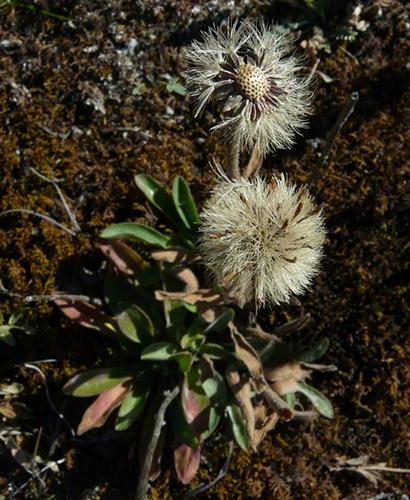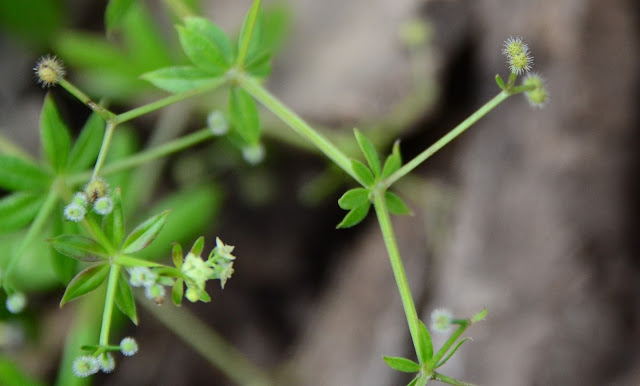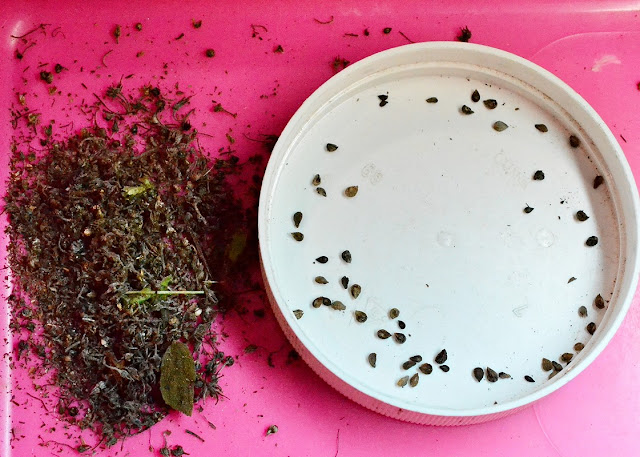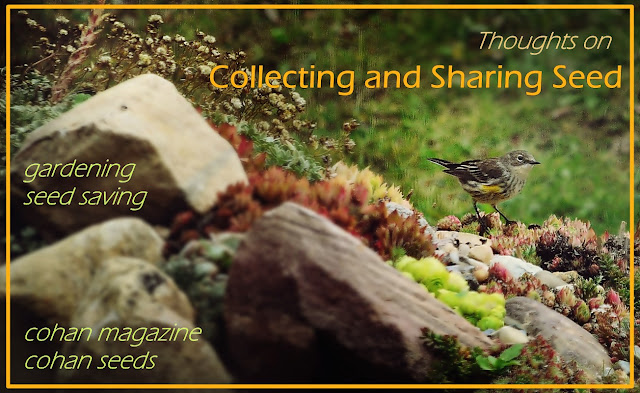If you've ever sown seed, you've experienced the sense of wonder and magic in those little packets: nature's mystery, the potential for a whole plant, even a tree! contained in a perfect tiny bundle, sometimes as fine as dust! Okay, so we know seeds are amazing, but have you ever stopped to think what happens before those seeds make their way into your hands? I've been trading seed for some years now, and have just started selling a little in the last couple of years-- always more to learn!
See my list at: https://www.facebook.com/cohanseeds/
 |
| Anemone virginiana var cylindroidea / Tall Thimbleweed with Epilobium angustifolium / Fireweed |
In some cases, the process is pretty straightforward, especially for common garden vegetables and flowers--nothing is much easier than saving seed from garden peas or beans, you can find easy tutorials on collecting tomato seed, and marigolds will give you a handful of clean seed with little effort. But those of us interested in wildflowers and natural plants grown in woodlands, meadows, rock gardens etc tend to grow a much wider range of plants, and the seeds vary as much as the plants do. There are pea family plants, much smaller seeds than the vegetables, but recognisable and still pretty easy to work with, ditto for relatives of carrots, generally, and things like poppies, but many others become much more complicated.
 |
| Oxytropis campestris / Field Locoweed - pretty easy to collect the little pea seeds from this! |
First off, if you are collecting the seeds in the wild (in which case, please always leave far more for nature than you take!) you need to be able to find and recognise the plant in seed. Sometimes easy and obvious- the plant may look just as it did in flower, but with seed capsules where the flowers were. Many times it is less so- the plant may have dropped or shrivelled its leaves, so that it can be hard to see, let alone recognise it, or it may now look much like any one of several cousins distinguished by flower colour or leaf shape no longer visible. Sometimes knowing where to look for the plant and which species was growing there is your only way of knowing what the seeds belong to. I've collected seed of several Oxytropis and Astragalus species (pea family) in the wild, and there is often not much to go on by the time I've seen them-- in this case, detailed knowledge of the type of seed pod would help, and sometimes looking at the arrangement of the dried leaves on the stems. I've also collected seed from several small composites (daisy family) with dried stems topped with seed heads (think dandelions or asters) and partly dried leaves at the base. In these cases I often had to wait for plants to grow to identify them, though if you knew what plants grew in the area, and some details like whether there were leaves on the stems or only at the base, and the colour of the pappus (the fluffy seed parachute) could help.
 |
| Unknown composite/ Erigeron? Near Nordegg, Alberta |
Second (you might say second, third and fourth-- these questions generally need to be answered simultaneously, though their relevance depends on the species), and this is just as tricky, if not trickier, once you've found your target plants, is to know where the seed is, how to access it, and whether it is ripe. Again, some easy ones, some not so much: say you are looking at berries- okay, easy to identify the fruits and collect them, but ripeness? you will need to know what is right for that species. Maianthemum canadense/ Wild Lily of the Valley, and its several cousins make beautiful berries which start green and pass through a stage of white/cream/tan with spots or stripes--- very striking and they look like ripe berries, but in fact, the berries have a long way to go yet, and end up deep red when mature! In other cases you need to figure out how to get at the seeds without spilling them. Campanula rotundifolia/ Harebells flower on slender stems, easily moved by wind or passing humans or other animals. The seeds later form in capsules with openings on the side so that when tipped or jostled, the seed will spill out. You can easily shake these over your collecting bag or vessel, but of course you can easily knock them on the ground. Zigadenus (Anticlea) elegans/ White (Death) Camas has flowers on long narrow stems, followed by a row of capsules which open on the top- like the Campanula they will release seed as they tip over ( a strong wind or a good bounce from a passing leg could send the seeds flying), While easily seen and accessed, the hard part here is tipping the whole long stem at once into your vessel as while you tip the top, the seed is spilling out the bottom; ideally you might snip off the stem so that you could tip it all at once into your bag. Of course if wild collecting, spilling a lot of the seed is good, you want to leave much of it in habitat, but if you are collecting in garden or from just a couple of plants, you may want to be more controlled!
Maturity/ripeness of seed, as mentioned above, is not always easy to judge. Corydalis aurea/Golden Corydalis is a native monocarpic plant (dies after forming seed). Yellow flowers are followed by fruits like tiny pea pods, which start green, eventually drying and opening to release the seed. Pick the pods too young and seed will not be mature, but wait too long and the seeds will be gone. You want pods that are full and fat, but still green or just drying, seeds inside will be black and ready to go! Asteraceae present another dilemma- wait too long and the seeds will blow away like dandelion fluff, harvest too soon and they will be unripe. Often a tug will let you know: if the seeds easily release with a light touch they should be mature, nature would not let a passing animal or gust of wind release unripe seed to be wasted.; if you have to pull hard, the seeds will come out, but are likely to be soft and immature.
 |
| Maianthemum canadense / Wild Lily of the Valley unripe berries |
Other plants present their own collection challenges. I've only collected seed of Linnaea borealis/Twinflower, a couple of times. On the one hand, the seeds are not too hard to find, one or two little (though not small for the size of the plant) little capsules, each containing one seed at the top of the dried flower stems. However, in my area, the plant rarely grows by itself, so you need to get right down there where you can peer and poke among the other low plants to find the Linnaea stems. Then, it is grab the seeds, and since they are sticky, you are not likely to drop them as you pull them out of the other vegetation-- getting them to let go of your hand and fall into the collection bag/vessel is another story! All in all, time consuming and picky work!
 |
| Linnaea borealis / Twinflower -sticky seeds! Maianthemum leaf behind |
Occasionally you do get a species which makes it fairly easy for you- Galiums (Bedstraws) have their tiny burs clustered on stem ends mostly away from leaves and without any crumbly capsules. When ripe they easily detach from the stems and can be grabbed a few or a handful at once, and come without much debris. Also easy are several (interestingly not all related) plants which make seed heads like mops or heads of hair , each seed with a long hair attached-- Geum montanum/Alpine Avens and Dryas Drummondii/ Yellow Mountain Avens (not that closely related in spite of the common names) in the Rose family is like this, as are several Anemones and their cousin Pulsatillas/Pasqueflowers. When ripe you can easily grab a handul of the long hair with no debris. Just watch for bugs! Which takes us to another issue for collection, insects, arachnids etc.
 |
| Galium boreale / Northern Bedstraw - tiny little burs! |
 |
| Galium triflorum / Sweet-scented Bedstraw - seeds and late flowers |
 |
| Geum montanum / Alpine Avens - unripe seedhead |
The goal of every organism is to grow, mature, extend physically and/or sexually. And the role of every organism is to occupy a place in its habitat and transform available resources (water, chemicals, minerals, sunlight, other organisms) into forms usable by themselves and yet other organisms which will feed on them and/or their waste. Part of that extremely complicated web involves flowering plants which take soil nutrients (in co-operation with soil bacteria and fungi), water and sunlight and transform them into leaves, stems, flowers and fruits/seeds. Those plant parts will feed and harbour insects and other invertebrates, browsing/grazing animals and birds (which also all can feed on one another) as well as providing for the next generation of the plants, and returning to the soil to feed the organisms there as they decay (along with waste from all the animals which fed on the plants!). Seeds, being in many cases a concentrated form of the plant's nutrients, are important in that web, feeding many insects, birds and animals directly. That could mean a tasty berry intended to lure an animal to eat the fruit and deposit the seed far from the parent, or thistle seeds delicious to birds who will devour the seeds, leaving nothing to germinate, but in the act of extracting the mass of fluffy seed, they may cast some to the wind to spread farther. After several years of uncertainty, I established that a small patch of Cirsium/Thistles on the acreage was in fact a native species, meaning I wanted to collect and share seed. Of course that was the same year that some bird realised they had nice big seeds to eat (think very small sunflower seeds) and ripped apart the seed heads, leaving not much but fluff-- though there were usually a few seeds missed or fallen from each flower.. if they were feeding at a windy moment, the plant's odds would be better. In other cases, like Castilleja/Paintbrushes, many seed capsules are lacking seed, full instead of waste left by insects that have consumed the seed. I don't know the insect responsible and whether or not it performs any function directly beneficial to the plant, but generally the plants produce far more seed than necessary, so the insects do no harm to the population.
 |
| Insects ( a ladybug? can't find a definiitve id, though I thought I figured it out a few years ago..) on a Galeopsis (weed).. don't know if they are feeding on the plant or another insect on the plant! |
More of an issue, with Castilleja and many other plants is the insects and spiders on the plant while you are collecting seed. generally plants where you can grab clumps of seeds or fruits and place in your bag/vessel or less affected, and those where you may be tipping or shaking the stems over your vessel are the worst. There are a number of true bugs and beetles which may be feeding on the seed, other plant parts, or each other as well as spiders of many sizes (mostly from near microscopic to small) which are likely to get dumped in with your seed. If true bugs or beetles are visible, you may be able to get them to fly away before you collect, though often they are inside capsules or otherwise hidden where you will not see them, same for spiders. Since a) I do not like to kill all these creatures which are doing their jobs in the ecosystem (closing them up in the bags will eventually kill them) and b) if I bring live bugs into the house I'll be in trouble! I try to get as many of them as I can to leave the bags- holding the bags open, angled upwards will allow many of them, both spiders and others, to escape-- the gneral instince for most of them when confined seems to be to head upwards. Of course there is seed, stem bits etc in the way to complicate their exit, and the rim of a ziplock bag can be an obstacle to a tiny creature! Sometimes I will pour seed into my hand to let the creatures crawl away, or if I am in the yard and it is not too windy, I will leave the bag on a flat surface, open and tilted upwards so they can leave at their own pace. Of course I can't get them all out :(
 |
| Halenia deflexa / Spurred Gentian - actually pretty in seed, with brown and gold seed capsules, golden leaves; collecting these will give you a bag full of bugs and spiders! |
Assuming you get through all of those pitfalls and you've got yourself some nice batches of seed, if you are going to share them with others, you will want to do some degree of cleaning of the seed (if you are just sowing yourself, this is not so important, apart from soft fruits as discussed below). As mentioned , this varies a lot-- obviously berries need the flesh removed, since it can rot or mould if kept moist, and even if drying, the flesh often has germination inhibitors. Also, if the package is to cross borders, soft flesh is likely a no no. Perhaps the most difficult are fine seeds that come from capsules or have surrounding bracts, leaves stems etc, the debris of which goes into the seed. Truly cleaning this sort of seed involves skills I don't have, and likely some equipment (bowls, fans, sieves?). It doesn't hurt to have much more seed than you need, since if you aren't afraid of losing some seed with the debris, you can more freely remove it! In other cases, you could save yourself a lot of grief by collecting with a light hand-- taking only the seed that freely falls, avoiding crushing capsules, leaves etc into your collection.
 |
| Anthyllis vulneraria / Woundwort Kidneyvetch - this was a different sort of collection: I didn't want to spill piles of seed onto the rock garden, so I snipped the stems off into a bucket! |
With cleaning comes sorting, and apart from tidiness and possible export regulations, it is more important. We are not simply talking about getting rid of bits of leaf to make your seed packet look pretty, but about sorting the good seed from the 'empties' or non-viable seed. Again the ease of this varies. With fine powdery seed, I suppose you might need a microscope, and I can't imagine anyone bothers-- the likely solutions would be a wet viability/germination test to get a sense of the percentage of good seed, and/or simply planting a large enough volume of the seed to hopefully get a good amount of germination. The same will be true for things like poppies, which produce large numbers of seeds, which while not dust fine, are small, and I for one cannot easily imagine trying to examine them individually. Luckily they *usually* seem to have good germination rates.
Some other species were lessons hard learned for me: for a couple of years I was sending off big masses of fluffy seed of various composites like Townsendia , Saussurea, Gaillardia to several trading partners. They were very kind and only mentioned in passing that only a small percentage of the mass was viable seed! I had to start looking much more closely: typical Asteraceae seeds are similar to dandelion seed-- a fluffy parachute/ pappus- and the little dry seed/ achene. The size of the seed varies a lot and while you see many obviously flat empty seeds, you can really only compare them to the same species. That is, a full viable seed for a tiny wild daisy might be no bigger than the empty seed of a more robust thistle. You need to look closely at many many seeds of the same species, since the rate of viability is so unpredictable- there are species I harvest that seem to have mostly good seed, and others for which the rate may be one in five, or one in twenty, and there may be individual flower heads with no good seed at all. For collections with a low rate of good seed, you may not even know what it looks like till suddenly you see a seed much bigger and fatter than the others and have that aha moment (often a discouraging moment when you realise you mostly have a big pile of nothing!). I grow a small South African alpine daisy, Felicia uliginoides, which most years has given me a half dozen seed heads or so. At say, 15-20 seeds per head, that would be a decent amount for my purposes, but once I started looking closely, I realised there were few good seeds indeed! The photo shows the grand total of 5 good seeds for all the empties in the background.
 |
| Felicia uliginosa / Alpine Blue Daisy - the mass of seed behind, the few good ones I found in the inset! |
 |
| Mertensia paniculata / Tall Bluebells --lots of debris to remove, painstakingly, but seeds are large enough that the final cleaning is not too much trouble. |
I came to a similar realisation this year with seed of Potentilla nitida/ Bright Cinquefoil/ Dolomite Cinquefoil. As this little alpine has gradually given me more flowers, I've collected more of the little fluffy balls of seed, rather happy that I was getting so much. Some of the seed was detaching from the fluff and settling in the bottom of the bag, while there were mounds of fluff with dark chunks/seeds on each little tuft. Well, as I looked more closely ( I had tried before, but apparently not hard/long enough, and my magnification equipment is not great) I finally had one of those aha moments-- there were some seeds clearly visible, some loose, most still attached to bits of fluff-- like a very miniature apple seed. These tiny but visibly plump seeds were far larger than the loose seeds at the bottom of the bag, and bigger and more distinct than the majority of the dark specks on most of the tufts :( Meaning, the loose 'seed' that settled out was absolutely nothing, and I had to go through the mounds of tufts bit by bit to separate out the plumper seeds (there are always seeds you are unsure of, and I tend to keep those, just in case, but *much* that can be discarded safely. If you were willing to sow a huge amount of seed to get a small number of plants, you could skip this step, but with time, space, soil, pots all limited for most people, most people would prefer to receive 10- 20 seeds with hopeful germination of at least half to two thirds of that rather than receive a hundred seeds with the same likely germination. So, this year, at very rough estimates, I have spent maybe an hour or so collecting seed of this Potentilla, and several hours sorting the seed, withat least another hour or two to go, and hopes of maybe 20 packets of seed, give or take a half dozen, when it's all done!
 |
| Potentilla nitida / Bright Cinquefoil / Dolomite Cinquefoil - lots of fluff, not so many good seeds! |
 |
| Saussurea riederi / Japanese Sawwort - another with mounds of seeds-- many blanks.. |
I've focussed mainly on some of the technical difficulties in seed collecting and processing, and may have scared away some folks-- but I hope not! Besides the great value in preserving and sharing species often not widely commercially available, if at all, there is a huge value in the process itself. First off, in order to collect the seed, you have to be outdoors, in the garden or in wild places. That is already a win! Take a moment to look up from the target plants and enjoy the sky- blue and sunny, grey and dramatic, heavy with impending rain-- or snow!. Look around and appreciate the surroundings-- a wild meadow or forest, a strip of wild vegetation beside a road or building, or your own garden. They all have their charms, and if there is desirable seed to collect there is some thriving bit of nature there. Some seeds of early flowering plants are collected in early to mid summer, but more and more seeds ripen as the season advances, and if you are out observing the plants you will be well positioned to notice the early autumn colour as it creeps into the landscape from the bottom up... before the trees turn their blazing fall shades, you can enjoy the pastel tones of woodland plants, the earthy colours of drying grasses, the blaze of late flowers and the busy activity of the pollinators on them.
So, get out there, collect some seed (responsibly), learn more about beloved plants and the places they grow, share and plant that seed and enjoy being a part of the rhythm of the seasons!
 |
| Symphyotrichum (Aster) ciliolatum (us)/ Fringed Aster / Lindley's Aster; early autumn and while some have already gone to seed, others will still be flowering until serious frost or snowfall. |
See my list at: https://cohanseeds.blogspot.com/
or visit: https://www.facebook.com/cohanseeds/

















Fascinating discussion. Excellent blog.
ReplyDeleteThanks for the comment :)
Delete